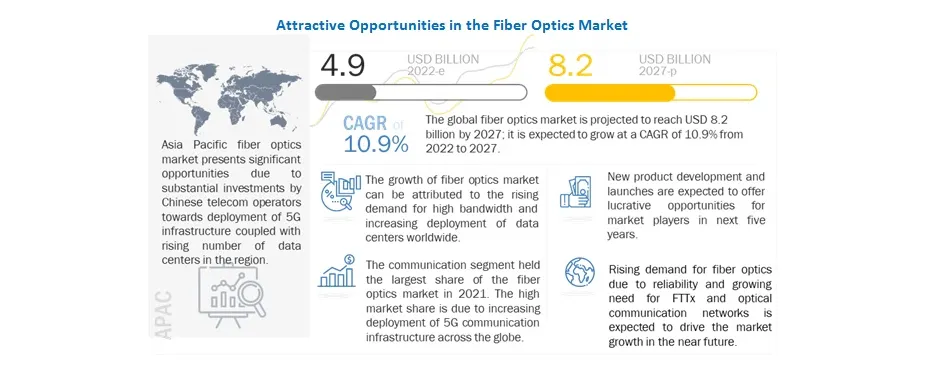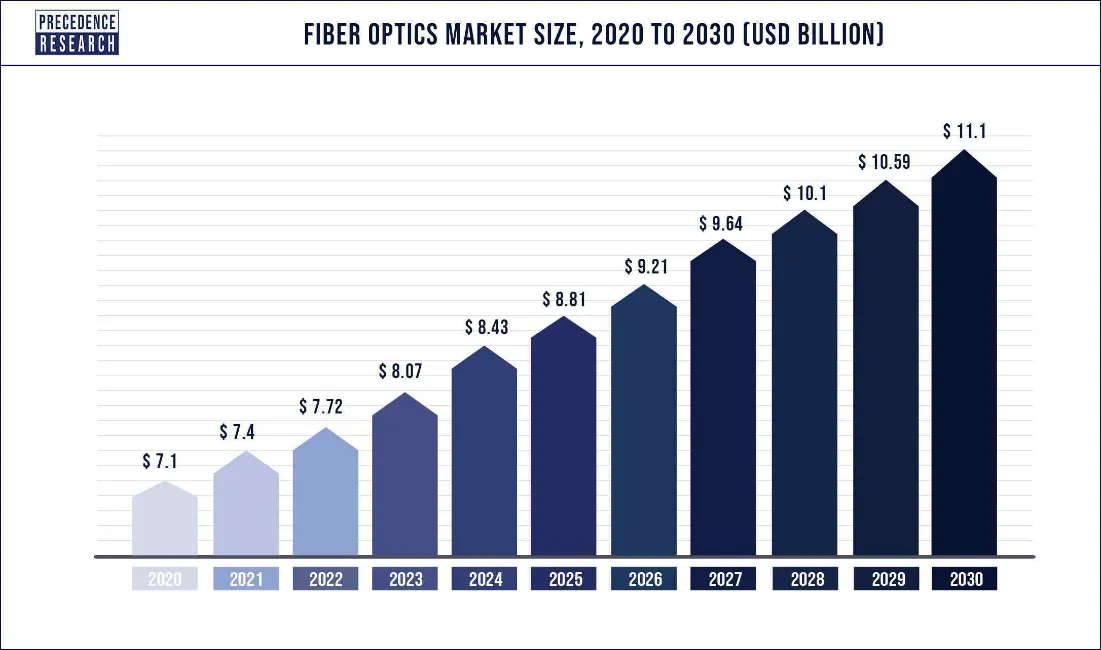Optical fiber has revolutionized the way we communicate and access information. From high-speed internet to advanced medical procedures, the benefits of fiber optic technology are vast and far-reaching. In this blog, we will explore the top 10 ways optical fiber has changed the world, highlighting the benefits of fiber optic internet and cable and delving into how fiber optic technology works.
Contents
- 1 How do optical fibers work?
- 2 Increased internet speeds
- 3 Improved communication
- 4 Advancements in medicine
- 5 Increased security
- 6 Improved energy efficiency
- 7 Enhanced entertainment experience
- 8 Improved industrial automation
- 9 Advancements in research
- 10 Improved environmental monitoring
- 11 New business opportunities
- 12 Conclusion
- 13 FAQs
How do optical fibers work?
Optical fibers are thin strands of glass or plastic that are used to transmit data in the form of light. They are made of a glass or plastic core surrounded by a cladding material with a lower refractive index. The core is where the light is transmitted, and the cladding helps to keep the light within the core by reflecting it back into the core if it tries to escape.
When light is shone into one end of an optical fiber, it is transmitted through the core by a process called total internal reflection. This occurs because the light is traveling from a medium with a higher refractive index (the core) to a medium with a lower refractive index (the cladding). When light hits the boundary between the core and the cladding at an angle greater than the critical angle, it is reflected back into the core rather than being transmitted into the cladding. This allows the light to travel long distances through the optical fiber without losing much intensity.
Optical fibers are commonly used in telecommunications systems to transmit data over long distances due to their ability to carry large amounts of data with minimal loss of signal strength. They are also used in medical equipment, industrial automation, and sensing applications due to their ability to transmit high precision and accuracy light signals over long distances.
Let’s look at the ways in which optical fibers have revolutionized the way the world works.
Increased internet speeds
One of the most obvious benefits of fiber optic internet is its increased speed. Traditional copper cables used in broadband connections simply cannot match the speed and capacity of fiber optic cables. With fiber optic internet, users can enjoy download speeds of up to 100 times faster than traditional broadband connections, making it possible to stream high-definition video, download large files, and participate in online gaming without interruption or lag.
Improved communication
Fiber optic technology has also greatly improved communication, both locally and internationally. Fiber optic cables can transmit data over long distances without degradation of signal, making it possible to connect people and businesses across the globe in real-time. This has led to the development of new communication technologies such as video conferencing, VoIP (Voice over Internet Protocol) and other cloud-based communication tools.
Advancements in medicine
Fiber optic technology has also played a crucial role in the advancement of medicine. Fiber optic cables are used in endoscopes, which are small, flexible tubes with a light and camera at the end. These endoscopes are used in various medical procedures, such as colonoscopies and laparoscopies, allowing doctors to view internal organs and diagnose diseases without the need for invasive surgery.
Increased security
Fiber optic cables are also highly secure, making them the preferred choice for sensitive data transmission. Unlike copper cables, fiber optic cables are not susceptible to electromagnetic interference, which means that data transmitted over fiber optic cables is not easily intercepted. This makes fiber optic technology ideal for use in applications such as banking and government communications.
Improved energy efficiency
Fiber optic technology is also more energy-efficient than traditional copper cables. Fiber optic cables have a much higher capacity for data transmission, which means that fewer cables are needed to transmit the same amount of data. This leads to a reduction in energy consumption, as fewer cables require less power to operate.
Enhanced entertainment experience
Fiber optic technology has also greatly enhanced the entertainment experience. Fiber optic cables are used in cable and satellite television systems, providing users with high-definition channels and improved picture quality. Fiber optic cables are also used in home theatre systems, providing users with a cinematic experience in the comfort of their own homes. The Fiber Broadband Association (FBA) conducted a study and found that the number of homes in the United States with access to fiber has surpassed 60 million, which is an increase of 12% from the previous year, where the number was around 54 million in 2020.

Image Credit : marketsandmarkets.com – Opportunities in fiber optics market
Improved industrial automation
Fiber optic technology has also led to the advancement of industrial automation. Fiber optic sensors are used in manufacturing, allowing for precise measurements and control of industrial processes. This has led to increased efficiency and productivity in the manufacturing industry.
Advancements in research
Fiber optic technology has also played a crucial role in advancing research in various fields, such as physics, chemistry and biology. Fiber optic cables are used in various scientific instruments, such as spectrometers, allowing for more accurate and precise measurements.
Improved environmental monitoring
Fiber optic technology has also greatly improved environmental monitoring. Fiber optic cables can be used to detect changes in temperature, pressure, and other environmental factors. This has led to the development of new environmental monitoring systems, such as those used to monitor earthquakes and volcanic activity.
New business opportunities
Finally, fiber optic technology has created new business opportunities. The increasing demand for high-new business opportunities in various industries. The increased speeds and capacity of fiber optic internet have led to the development of new technologies and services, such as cloud computing and the Internet of Things (IoT), creating new market opportunities for businesses. Additionally, the increased security and reliability of fiber optic cables have led to the growth of industries such as data centers and disaster recovery services.

Image Credit : precedenceresearch.com – Market size
Conclusion
In conclusion, fiber optic technology has greatly impacted the world in many ways, providing faster internet speeds, improved communication, and advancements in various fields such as medicine, industry, and research. The benefits of fiber optic internet and cable are clear. As technology continues to evolve, it is likely that we will see even more ways in which fiber optic technology will shape our world. It’s also important to mention that fiber optic technology is also very reliable, with less signal interference as well as less cable maintenance compared to traditional copper cables. With the proliferation of internet-enabled devices and services, the need for faster and more reliable internet will only continue to grow, making fiber optic technology an essential component of our digital infrastructure.
FAQs
Q. How do optical fibers help in delivering data?
A: The widespread adoption of optical fibers in homes worldwide has greatly impacted how we consume and transfer data. While copper cables may offer data rates in the tens of megabits, optical fibers provide gigabits of data into the home, enabling the rise of on-demand video streaming and digital services. Optical fibers provide higher reliability in both residential and office environments and have a lower environmental impact and cost compared to copper cables. Additionally, optical fibers are less likely to be targeted for theft as they are not as valuable as copper.
Q. Can optical fibers be used as sensors?
A: Optical fibers have diverse applications, including being used as sensors. The movement of fibers can alter the light inside, and these changes can be detected. Optical fibers have been installed in concrete to monitor stresses and strains in buildings that cannot be detected otherwise. They can also measure temperatures in hostile environments, such as down oil wells, without being affected by electromagnetic interference. Fiber woven into fabrics can even generate power for wearable computers while also providing temperature data. Optical fibers also play a crucial role in modern aviation, kilometers of doped fibers coiled in a gyroscope can detect motion with a much higher degree of accuracy than GPS navigation, helping guide aircraft and ships safely around the world.
Q. How have optical fibers enabled the quantum revolution?
A: Optical fibers have been around for over a century, but the technology is now at the forefront of quantum encryption developments. As quantum computers become more widely available, they will be able to break current encryption methods, making new technology essential. Quantum encryption uses entangled photons, which allows them to be used as cryptographic keys. These keys are transported by fiber optic cables, ensuring secure data transfer. Optical fibers also connect the internet, data centers, and have applications in Industry 4.0, ultrafast broadband and medical innovations, even in extreme conditions.
Q. How does optical fiber help save lives?
A: Optical fibers have a wide range of applications beyond data transfer. They are also used in medical procedures, such as keyhole surgery, where fibers with tiny cameras on the end allow surgeons to see inside the body. Additionally, fibers in the same cable can carry high power laser light, allowing for precise cutting of growths and tumors, minimizing damage to surrounding tissue. This technology continually advances and discovers new ways to diagnose and treat various medical conditions. Fibers are also used in endoscopy procedures and even in optical coherence tomography, a non-invasive medical imaging test used in the early detection of eye-related diseases.
Q. How does fiber optics help in agriculture?
A: In agriculture, fiber optic soil sensors can aid in sustainable farming practices by monitoring water retention in the soil and activating drip irrigation systems only when necessary, reducing water wastage and ensuring optimal moisture levels for crops. Fiber optic sensors can provide farmers with valuable information about the growth and development of their crops by monitoring the soil and detecting changes in root structures. These sensors can offer near real-time data on the size and location of root systems, allowing farmers to adjust their farming practices, such as watering and fertilizer use to promote healthy and resilient crops without the need for manual digging.















